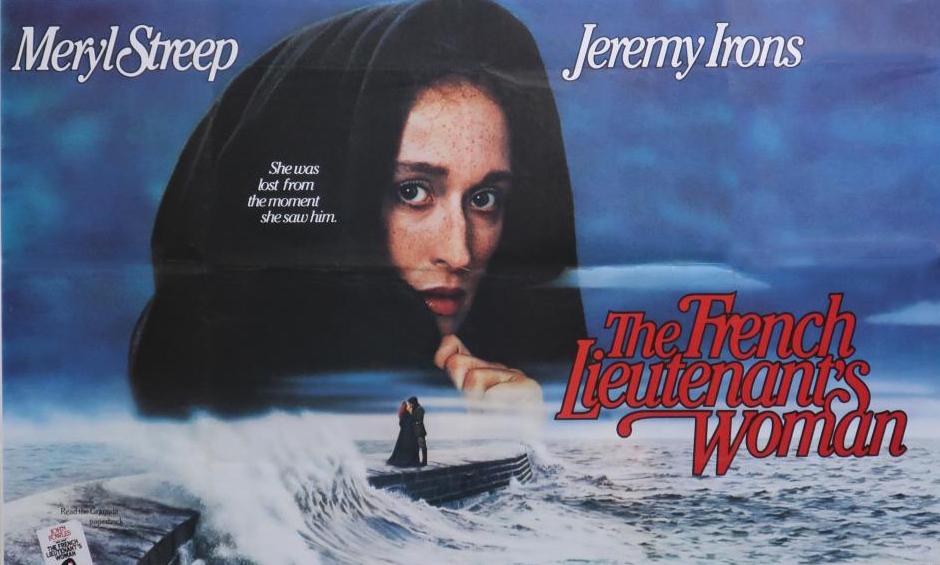By Harry Mottram: Frankly Charles is a bit of an idiot. He’s sexually frustrated and isn’t in love with his moneybags fiance Ernestina and fancies the mysterious Sarah Woodruff. She spends some of her time off from the employ of the ghastly Mrs Poulteney by standing at the end of the sea wall on the Lyme regis Cobb getting soaked by the sea spray in what is certainly not a rain proof cloak.
An initial glance at the cover of John Fowles’ novel The French Lieutenant’s Woman suggests it’s a 19th century romance. Written in 1969 it’s usually described as a post modern historical fiction novel since instead of simply charting the relationship of Charles and Sarah it investigates aspects of Victorian society through the characters who represent various themes and attitudes back then. Sarah who appears on most covers of the novel standing at the end of Lyme Regis Cobb or harbour wall is the main protagonist despite her mysterious persona which bewitches Charles who initially would seem to be the main character but is a pompous twit.
The novel is also known for the 1981 film interpretation directed by Karel Reisz with its screenpaly by Harold Pinter in which Fowles’ book is deconstructed and recreated as a paralell story – that of a film company making a movie of the novel – which mirrors to an extent the narrator who interjects with his thoughts throughout the book. Meryl Streep plays Sarah and also the actress Anna who portrays her. She is in a relationship with Mike (Jeremy Irons) who is the actor playing Charles and her French lover creating another paralell with the the French Lieutenant in the book.
It’s a neat narrative device as it allows us to contrast the two relationships which would appear very different since they are approximately a century apart. Sarah is the victim of the misogyny and religious of Victorian England – it’s a choice between being a Governess or a prostitute with very few career oppotunities for women – while Charles has the luxury of the life of an idle bachelor as he chips away on the fossils of the Jurassic coast.
In one of the paralell scenes Charles and Sarah meet by chance in the Under Cliff – a green paradise between Seaton and Lyme Regis – and she is partly stand offish and mysterious – she maintains her independence by not immediately falling for Charles who clearly fancies her over his fiance Ernestina. In the making the movie part of the film there’s a scene which echoes the meeting in the green paradise as the two actors rehearse the scene. Anna is slightly elusive as they rehearse with little eye contact until the last moment – keeping her distance despite the fact they are sleeping together.
On one level an anti-romance that explores depression, repression and the inequalities of 19th century society in an era before many of the reforms that were to transform society. Sarah draws in and plays with Charles’ emotions but also ultimately rejects him – although Fowles’ as the narrator offers a number of outcomes.
The novel is very detailed with much information from the narrator of cultural references and scientific and social trends from fashional hats to Charles Darwin. We realise that Charles is essentially a pseudo interlectual who can indulge his interests such as geology and paleontology but destroys one of the last great bustard birds – soon to be extinct in England. In contrast Sarah is really on a journey to find herself despite the entanglements with the French Lieutenant and Charles – and her lowly position in society as a ‘fallen woman.’ It’s a tricky read with so much going on and the realisation this wasn’t the straight forward gothic romance I had expected.
The movie seemed to be lit like a dismally gloomy Victorian drawing room with only just enough light to see what was happening – and in the sex scenes you can’t even see that! Even many of the outdoor scenes seem to have been shot of heavily overcast days although the final shot on the lakes does suggest a happy ending – in contrast to sulking strop Mike who hosts a party at his home and fails to understand he has a lovely home and family – and pines for flip-flop Anna. But however confusing and dimly lit the acting is superb and Meryl Streep and Jeremy Irons are compulsive viewing.
I was drawn to the novel and the movie largely due to it being in Lyme Regis near to my childhood home of Seaton and of course the romantic vision of Meryl Streep at the end of the Cobb. Beauty, geography and an insight into the 19th century in Dorset. A perfect combination.
This week there is play version of the novel at the Minack Theatre in Cornwall adapted for the stage by Mark Healy.
See https://www.minack.com/whats-on/french-lieutenants-woman

